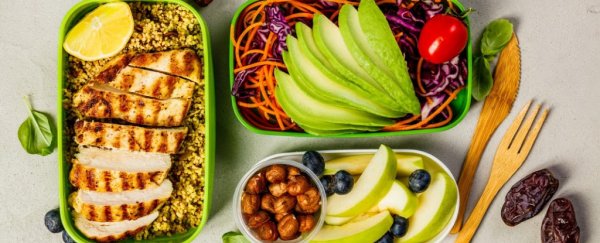When people are in a hurry to lose weight, they often turn to fad diets that limit entire food groups.
Studies suggest the tactic can help dieters shave off extra pounds in the short-term.
But then it backfires, sending people back where they began on the scale or locked in a vicious cycle of gaining and losing weight – which can do long-term damage to the heart and lead to early death.
Two of the most talked about fad diet plans these days are keto and Whole30. Here's the difference between them, and what the science says about each.
Keto versus Whole30
The main factors that distinguish the two diets are that the keto diet pushes people to eat fewer carbs and ramp up their fat intake, while Whole30 is focused on banning junk food, sugar, and some other convenient staples. This is how the basics break down:
The keto diet aims to get the body into ketosis. That's the state in which the body burns fat for fuel instead of carbohydrates.
In order to do that, most keto diets recommend people stick to about 30 grams of carbs a day, which means that there's barely any room for sugar, including natural sugars from fruits and vegetables.
Keto dieters are encouraged to eat: Creamy and fatty foods like avocados, oils, nuts, meat, eggs, cheese, and cream, along with certain vegetables like kale and cauliflower.
The plan does not allow: Many carbohydrates at all. Apples are essentially banned, as is milk (though cream and cheese are allowed, since they're fattier and have less sugar).
It's also hard to eat some vegetables like carrots on the plan because of their sugar content. The diet requires daily mental maths to calculate how much protein, carbs, and fat a person is eating in order to make sure they maintain a state of ketosis.
The Whole30 diet is often billed as a way to re-work one's relationship with food. It starts with a month long "nutrition reset", in which all grains, sugars, breads, desserts, alcohol, dairy, legumes, and processed foods are banned.
Whole30 followers are encouraged to eat: Mostly home-cooked meals rich in veggies, meat, eggs, fish, and fruit.
It does not allow: Alcohol, bread (including gluten-free varieties), whole grains, beans, sugar, dairy (including butter), legumes like beans, peanuts, soy, MSG, processed snacks, or "comfort" foods like pancakes or desserts.
There's also no weighing yourself allowed during the first month.
But beyond these basic differences, there's another important distinction.
The ketogenic diet is a doctor-recommended strategy for some patients with obesity and epileptic seizures
The ketogenic diet was first developed in the 1920s as a clinical strategy for dealing with epileptic seizures in kids that weren't responsive to other treatments.
Doctors found that the diet, which focuses on getting patients 70-80 percent of their daily calories from fat, and very little (if any) from carbohydrates, changed the way those patients' bodies processed food. Results showed that the shift in eating patterns led to fewer seizures.
On a typical keto diet, it takes about five days of following the high-fat, low-carb plan for people to enter a state of nutritional ketosis, in which the body is running on fat. It's the same survival mechanism that gets ignited when people are starving – the body shifts to using fat stores.
A typical macronutrient ratio on a keto diet would be around 70-80 percent fat, roughly 15 percent protein, and no more than 10 percent carbs.
A well planned keto diet should include plenty of fibre and other essential nutrients like vitamins and minerals from nuts and vegetables. That's drastically different from what Whole30 endorses.
Today, celebrities like LeBron James and the Kardashian sisters, as well as plenty of Silicon Valley biohackers and some scientists, adore the plan.
Many followers say it helps reduce their appetite and eliminate brain fog. Some doctors have started recommending the strategy to overweight and obese patients as well.
But the high-fat regimen isn't for everyone: Keto diets are not recommended for people who've had kidney or liver issues. And its still unclear what the long-term health consequences of the diet are.
Anyone thinking about trying keto – or any other restrictive diet – should chat with a doctor or registered dietitian before they begin.
Whole30 was invented by a husband and wife in 2009
The Whole30 plan makes a comeback on Instagram every time a new year or swimsuit season rolls around.
Many people like its one-month food reset. But Whole30 isn't designed to be completely over after 30 days.
Rather, the idea is that after an initial month of severe restriction, dieters start re-introducing formerly banned foods into their daily eating plans slowly, deciding which their body likes best.
Nutritionists are generally sceptical about the Whole30 regimen. US News and World report consistently puts the plan near the bottom of its annual diet ranking because experts agree that it's extremely hard to follow.
Plus, the diet excludes healthy whole grains and beans, which research consistently finds are great sources of nutritious dietary fibre that helps people stay satiated until their next meal.
Fibre also helps maintain the immune system and reduces inflammation in the body, making fibre-eaters more disease-free and less likely to develop cancer.
Simply put, Whole30 is not backed by science – a month isn't enough time to re-set your digestive system, anyway.
"Thirty days isn't enough time to turn off systemic inflammation," Alessio Fasano, director of the Center for Celiac Research and Treatment at Massachusetts General Hospital, recently told Time.
Instead of Whole30, most nutritionists agree that plant-based diets centered on veggies, whole grains, and lean proteins (like beans) are the way to go.
This article was originally published by Business Insider.
More from Business Insider:
